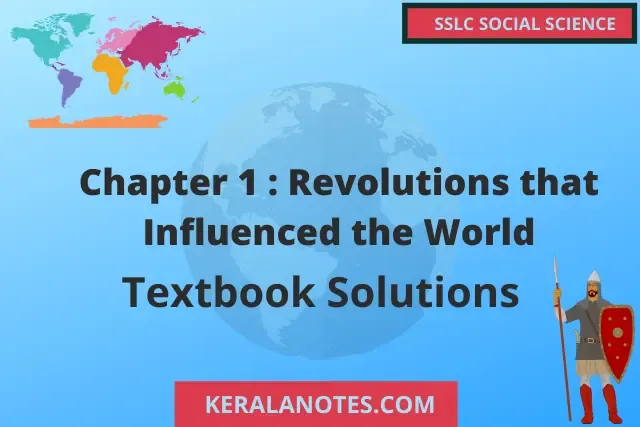Kerala SSLC Social Science textbook solutions are available for free download on our website for chapter 1 revolutions that shaped the world of SSLC study guides for social science 10th standard SCERT textbooks. Here you can access the chapter 1 revolutions that changed the globe answer from the Kerala SSLC Social Science textbook.
In the history of mankind, revolutions have occurred frequently. These revolutions occurred in the past as well as now and had a significant influence on society that is clear to anybody studying history or living today. The previous revolutions, such as those that took place in France and Russia, had a significant impact on the subsequent upheavals.
The outline of several significant revolutions that had a significant influence on the world we live in is provided in this chapter of the SSLC social science textbook Revolutions and How They Changed the World. It included the French Revolution.
| Board | SCERT, Kerala |
| Text Book | SCERT Based |
| Class | SSLC |
| Subject | Social Science Solution |
| Chapter | Part I - Chapter 1 |
| Chapter Name | Revolutions that Influenced the World |
| Category | Kerala SSLC |
Kerala Syllabus SSLC Class 10 Social Science Textbook Solution Chapter 1 Revolutions that Influenced the World
- Chapter 1: Revolutions that Influenced the World
- Chapter 2: World in the Twentieth Century
- Chapter 3: Public Administration
- Chapter 4: British Exploitation and Resistance
- Chapter 5: Culture and Nationalism
- Chapter 6: Struggle and Freedom
- Chapter 7: India after Independence
- Chapter 8: Kerala towards Modernity
- Chapter 9: The State and Political Science
- Chapter 10: Civic Consciousness
- Chapter 11: Sociology : What? Why?
- Chapter 1: Seasons and Time
- Chapter 2: In search of the source of wind
- Chapter 3: Human Resource Development in India
- Chapter 4: Landscape analysis through maps
- Chapter 5: Public Expenditure and Public Revenue
- Chapter 6: Eyes in the sky and Data analysis
- Chapter 7: India : The Land of Diversities
- Chapter 8: Resource Wealth of India
- Chapter 9: Financial Institutions and Services
- Chapter 10: Consumer : Satisfaction and Protection
SSLC Social Science Part I
SSLC Soical Science Part II
Chapter 1 Revolutions that Influenced the World Textbook Solution
- 'American War of Independence was a movement of the English against England'. Substantiate…
- How did the resentment of the middle class lead to the French Revolution?…
- Arrange the following events in chronological order.i. February revolutionii. Long…
- How did the French Revolution influence the reforms of Napoleon?
- How did colonial rule influence Latin American countries?
- 'Russian Revolution helped the progress of the working class'. Do you agree with this…
- How did China become a people's republic? Analyze
Lets Assess
Question 1.'American War of Independence was a movement of the English against England'. Substantiate the statement
Answer:
The American War of Independence was a movement of English against England. This statement can be explained with the following points:
1. The motto of the American War of Independence was ‘No taxation without representation’. This was given by James Ottis.
2. The people demanded representation in the government. The government was said to be anti-people if people were not included in it.
3. From the 16th century, the Europeans began to migrate to North America to exploit their resources.
4. By the 18th century, the British had established 13 colonies in North America.
5. These colonies were the centres of collecting raw materials for the British industries and a market for selling their goods. This policy was called the mercantilist policy.
6. Other mercantilists laws included that only the British ships were to be used to carry the goods, and the products must only be exported to England.
7. All the legal papers must carry British stamps.
8. The colonies must provide food for the British troops.
9. Import tax must be paid frot he import of tea, glass, paper, etc.
10. These laws negatively affected the colonies of the people of colonies.
11. For example, the restriction on trade leads to the complete downfall of the domestic trade of the colonies.
12. These laws were against the rights and liberty of people.
13. The increase in tax and stamp duty lead to inflation in the economy
14. Thus, it is rightly said that the American War of Independence was a movement against England.
Question 2.
How did the resentment of the middle class lead to the French Revolution?
Answer:
1. Prior to the French Revolution, France was ruled by an autocratic rule in a reckless manner.
2. Nine-tenth of the population died of hunger and one-tenth of indigestion.
3. The majority of people were living in a state of misery.
4. A great degree of socio and economic inequalities existed in the country.
5. The society was divided into 3 estates-Clergy, nobility, and the middle class.
6. The middle-class consisted of traders. writers, lawyers, teachers, bankers. farmers and craftsmen.
7. This was the lowest social status that played no role in the administration.
8. They paid taxes to the clergymen and the nobility as well as a land tax or taille to the government.
9. Many thinkers such as Voltaire and Rosseau inspired the people to revolt against this tyranny.
10. The luxurious life of the rulers coupled with drought, crop failure, etc led to the bankruptcy of the French government.
11. King Louis XVI called upon the representatives of all the three estates to discuss the introduction of new taxes on the people.
12. Usually, the clergy and the nobility overruled the middle class.
13. The members of the Third Estate declared themselves as the ‘National Assembly of France’. They gathered in a tennis court and decided not to leave until the framing of a Constitution, This was called the ‘Tennis Court Oath’.
14. Various events followed this such as on the 14th of July 1789, the revolutionaries stormed with the slogans of ‘liberty, equality and fraternity’. they demolished the Bastille prison and this was the commencement of French revolution.
15. Soon, the National Assembly passed the Declaration of the Rights of Man and the Citizen.
16. In October 1789, thousands of women marched from Paris to the Palace of Versailles with the slogan ‘Give us bread’.
17. In September 1792, the national convention was formed as per the new Constitution, proclaimed France as a republic.
Question 3.
Arrange the following events in chronological order.
i. February revolution
ii. Long March
iii. American Declaration of Independence
iv. Tennis Court Oath
Answer:
i. American Declaration of Independence
ii. Tennis Court Oath
iii. February revolution
iv. Long March
Question 4.
How did the French Revolution influence the reforms of Napoleon?
Answer:
The French had to bear the autocratic rule of Napolean Bonaparte for a short period of time. He seized the power in 1799. He instituted many reforms which were influenced by the French Revolution. The reforms introduced are mentioned below:
1. The farmers were made the owner of the land.
2. ‘A sinking fund’ was formulated to avoid public debt.
3. Transportation was improved by constructing many roads.
4. The state-controlled the clergy.
5.’Bank of France’ was established for the maintenance of finance.
6. The existing laws were codified and a new code of law was implemented.
Question 5.
How did colonial rule influence Latin American countries?
Answer:
Latin America was under the colonial rule of Spain and Portuguese for several years. The influence of colonial rule is mentioned below:
1. The colonial rule enforced their culture, language, religion, and customs.
2. They built Churches and houses in their own style.
3. The schools promoted the Spanish system of education.
4. The Spanish methods of farming were introduced.
5. New diseases spread over from Europe to Latin America.
6. Natives faced racial discrimination.
7. The resources and wealth of Latin Americans were looted.
8. They had complete control over trade and the people became slaves.
Question 6.
'Russian Revolution helped the progress of the working class'. Do you agree with this statement? Why?
Answer:
The demands of the workers in Russia were the following:
1. The private property should be abolished
2. Everyone must be giving work
3. The authority must be given to the people and the workers
4. The production control must be in the hand of the people
The circumstances that led the workers to demands the above were the following:
1. Russia was under the autocratic power of Tsar. The farmers and factory workers lead a tragic life.
2. The agricultural production was very low which affected the farmer's income.
3. Heavy taxes to be paid by the landless farmers.
4. Although Russia was rich in natural resources, the industrial production was very low.
The Marxist ideology focused on the establishment of the Supremacy of the workers instead of the capitalist. Trade unions were set up for the promotion of the workers.
Several other circumstances which led to the Russian Revolution were the following:
1. Great influence by the political leaders
2. After the effects of the first world war
3. The defeat of Russia by Japan in 1905
It is said that the Russian Revolution helped the progress of the working class because the consequences of this revolution favoured them. This can be explained in the following points:
1. The land was distributed to the farmers instead of the lords.
2. Factories, banks, transport, and foreign trade were brought under public ownership.
Question 7.
How did China become a people's republic? Analyze
Answer:
The colonial power of Europe and America adopted certain policies which were different than the ones they had implemented in the colonies of other parts of the world. These are mentioned below:
1. Opium trade policy: Chinese tea and silk were demanded all over Europe. China gained a lot of profit by exporting these to Europe. There was no import from Europe. The European traders suffered a lot. As a remedy, British traders imported opium which negatively affected the Chinese people. It led to economic and mental subjugation of the Chinese.
2. Open door policy: Europeans engaged themselves in trade with China, but not America. American argued for the open door policy. It meant equal rights and opportunities for all countries in China. China was divided into different regions to be controlled by different countries. The aim of this policy was to create an opportunity for America to interfere in China.
The revolutions that took place in China are mentioned below:
1. Boxer Rebellion: A secret agency rebelled against the favouring of foreign interference by the Manchu dynasty. The Emblem of this agency was a boxer's fist. Although this Revolution failed, it inspired many other revolutions.
2. Revolution under Sun Yat Sen: It ended the monarchy in China. A Republican government under Sun Yat Sen was formed. He focused on the ideologies of nationalism, socialism, and democracy. He nullified the unjust treaties with foreigners. He advocated the importance of agriculture and industry. He received assistance from Russia. Communist Party was formed
Extended Activities
Question 1.Collect the works of the thinkers and writers who influenced various revolutions and prepare a note,.
Answer:
The different thinkers and writers who have influenced various resolutions are :
1. James Ottis - Lawyer in Colonial Massachusetts. Gave the slogan for the American War of Independence-’No taxation without representation’.
2. John Adams-Second President of USA. He said that the revolution was already in the minds of people before the war commenced.
3. John locker- An enlightenment thinker and Father of Liberalism. He said that everyone has fundamental rights and the government has no right to suspend them.
4. Thomas Paine- Common Sense and the American Crisis
5. Thomas Jefferson-Third President of USA. He was the author of Declaration and a proponent of democracy, republicanism and individual rights.
6. Benjamin Franklin-He was the sixth governor of Pennsylvania. he was a major figure in American enlightenment and one of the founding fathers of USA.
7. James Madison- The fourth President of the USA and the Father of the Constitution of USA. He was also a member of the Continental Congress.
8. Montesquieu promoted the division of power into three- The legislature, the executive and the judiciary.
9. Voltaire who influenced the French Revolution. He was against the exploitation of the clergy. He advocated a rational thinking mechanism, humanism, and equality.
10. Rosseau explained the importance of freedom during the French Revolution. He wrote in a book called the ‘Social Contract’. He said ‘Man is born free but everywhere he is in chains’.
Question 2.
Collect information on important revolutions in the world and prepare a magazine.
Answer:
The different important revolutions in the world are:
1. Xinhai revolution: It was the revolution in 1911 in China. It led to the collapse of the last Imperial dynasty in the country-the Qing dynasty. It played an important role in forming the social economic policy but was a cause of violence in Chinese history. The main cause of the revolution was growing public disdain of the dynasty. It was accused of having negative policies and was not able to bring the country on the path of development. It lasted for 4 months at the end of which the provisional government of the Republic of China was established.
2. Cuban revolution: It was a revolution in the islands of Cuba. It started on the 26th of July 1953 and ended after five years on the 1st of January 1959. The citizens of Cuba faced a high level of unemployment, rising inflation, and limited water resources. The Batista led authoritarian government was overthrown and a Revolutionary socialist government was imposed.
3. Revolution of 1848: It was a series of revolutions in the year 1848 all over Europe. The countries involved were France, Germany, Italy, Poland, Hungary, and Austria. The revolution occurred at the same time across the countries but there was no coordination among them. It leads to the end of the feudal system of Government and democracy was established.
4. Industrial revolution: This was a global movement in the early 19th century. It was initiated in Great Britain. The use of steam power was increased, hand production methods were transited to mechanization, and a new factory system was introduced. It created many job opportunities and improved the standard of living of the people. It is said to be the most critical phase of human civilization by economists.
5. Haitian revolution: It lasted for 12 years from 1791 to 1804. The people were fighting against delivery and it proved to be a successful anti-slavery war at the cost of thousands of lives. This later became an inspiration for many civil rights movements in the 20th century.
SSLC Social Science Textbook Solution
- Chapter 1: Revolutions that Influenced the World
- Chapter 2: World in the Twentieth Century
- Chapter 3: Public Administration
- Chapter 4: British Exploitation and Resistance
- Chapter 5: Culture and Nationalism
- Chapter 6: Struggle and Freedom
- Chapter 7: India after Independence
- Chapter 8: Kerala towards Modernity
- Chapter 9: The State and Political Science
- Chapter 10: Civic Consciousness
- Chapter 11: Sociology : What? Why?
- Chapter 1: Seasons and Time
- Chapter 2: In search of the source of wind
- Chapter 3: Human Resource Development in India
- Chapter 4: Landscape analysis through maps
- Chapter 5: Public Expenditure and Public Revenue
- Chapter 6: Eyes in the sky and Data analysis
- Chapter 7: India : The Land of Diversities
- Chapter 8: Resource Wealth of India
- Chapter 9: Financial Institutions and Services
- Chapter 10: Consumer : Satisfaction and Protection
SSLC Social Science Part I
SSLC Soical Science Part II
SSLC Social Science Related Links
| SSLC Social Science Notes | Click Here |
| SSLC Social Science Textbook Solutions | Click Here |
| SSLC Focus Area | Click Here |
| SSLC Previous Year Questions with Solution | Click Here |
| SSLC Latest Syllabus | Click Here |
Other Related Links
| SSLC Physics | Click Here |
| SSLC Chemistry | Click Here |
| SSLC Mathematics | Click Here |
| SSLC Biology | Click Here |
| SSLC Social Science | Click Here |
| SSLC English | Click Here |






